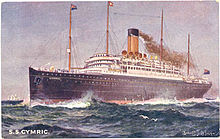Cymric (ship)
|
||||||||||||||||||||||
|
||||||||||||||||||||||
|
||||||||||||||||||||||
|
||||||||||||||||||||||
|
||||||||||||||||||||||
The Cymric was a passenger ship of the British shipping company White Star Line , which entered service in 1898 and was built for passenger and freight service between Great Britain and the United States . On May 8, 1916, the Cymric was sunk by a German submarine during World War I on the southern Irish coast .
The ship
The 13,370 GRT steamship Cymric was built at the Harland & Wolff shipyard in Belfast , Northern Ireland , and was launched there on October 12, 1897. On February 5, 1898, she was handed over to the White Star Line, which she planned to transport passengers, mail and cargo for the route Liverpool - New York . It took the ship an average of ten days to cross this route.
At the time of her commissioning, she was the largest ship on the White Star Line. The Cymric also had the largest loading capacity of the White Star fleet at the time, at 18,000 tons. On April 29, 1898, she left Liverpool on her maiden voyage . It was named after the term "Cymru", the old Welsh name for Wales . The prominent passengers carried by the Cymric included the German composer Fritz Steinbach .
The regular passenger transport service of the Cymric was repeatedly interrupted during her service. In the spring of 1900 she made two trips as a troop transport in the Second Boer War from Liverpool to Cape Town and at the beginning of the First World War , like many other liners, she was requisitioned by the British Admiralty and used again as a troop transport.
On November 3, 1903, the steamer set off for its last transatlantic crossing to New York, then from December 10, 1903, it sailed the Liverpool – Boston route. It was not until December 20, 1914, that the Cymric was back on the Liverpool – New York route. On March 28, 1915, she was less than 20 miles from the passenger steamer Falaba when it was attacked and sunk by a submarine off the coast of Wales. The Cymric received express instructions from the Admiralty not to come to the aid of the Falaba so as not to endanger herself.
The journey on January 28, 1916 from New York to Liverpool was the last on which the Cymric had passengers on board (62 first class, 64 third class). On the following crossings she only transported freight. Her last journey was completed on Thursday, April 13, 1916.
Sinking
On Saturday, April 29, 1916, the Cymric set off with 106 crew members and six passengers on board in New York for another voyage to Liverpool. It was the first trip in three months that the ship carried passengers again. They were British consulate workers. Their cargo included a large amount of war equipment, i.e. contraband , including firearms, cannons, gunpowder , ammunition cases , and aircraft and car parts. The command was Lieutenant Frank Ernest Beadnell of the Royal Navy Reserve, who had been with the White Star Line for 20 years and, among other things, had also been the captain of the Baltic . The ship was not armed.
On Monday, May 8, 1916, around 4 p.m., the Cymric was torpedoed and sunk on the south coast of Ireland 140 nautical miles northwest of Fastnet Rock by the German submarine U 20 under Lieutenant Walther Schwieger , killing a total of five crew members. The torpedo hit the engine room . Four men died in the subsequent explosion . Very popular with White Star guests, chief steward James Bannerman Malcolm drowned before he could reach a lifeboat . All six passengers were rescued.
The submarine was sighted by the Cymric , but Schwieger attacked without warning and then disappeared again. Although the U 20 fired three torpedoes at the liner, it took eleven hours for it to sink. It was the same submarine under the same commander, which is already the Lusitania of the Cunard Line (1,198 deaths) and the Hesperian of the Allan Line (32 deaths) had sunk.
The 107 survivors were brought to the southern Irish port city of Bantry . Although there were no Americans on board, the American consul in Queenstown , Wesley Frost , made his way to Bantry to meet the survivors. Except for one Russian and two Belgians, all of the people on board were British.
Web links
- Technical and historical details in the ship database Norway-Heritage
- The Cymric in the submarine database
- The Cymric in a listing of ships that the White Star Line lost in both world wars
- Link to a photo of the Cymric
- Some contemporary newspaper articles about the sinking on Encyclopedia Titanica , an online encyclopedia about crashed ships

